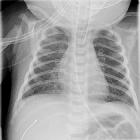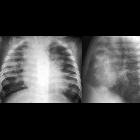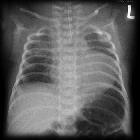neonatal pneumonia


Neonatal pneumonia refers to inflammatory changes of the respiratory system caused by neonatal infection.
Epidemiology
It is one of the leading causes of significant morbidity and mortality in developing countries. Neonatal pneumonia accounts for 10% of global child mortality. At the time of writing it is thought to account for 750,000 to 1.2 million neonatal deaths annually .
Risk factors
Exposure to these organisms occurs in the following cases:
- rupture of membranes more than 6 hours before delivery
- prolonged and complicated labors
- premature infants
- immune disorder
Clinical presentation
Neutropenia with temperature instability.
Signs and symptoms include:
- tachypnea
- chest recession
- apnea
- respiratory distress
- cough (absent in two-thirds of the cases)
Pathology
Etiology
Occurs with transplacental spread. Aspiration of infected amniotic fluid after prolonged rupture of membranes or during delivery.
Agents
Maternal systemic infection:
- rubella
- cytomegalovirus
- Treponema pallidum
- Listeria monocytogenes
- tuberculosis
- HIV
- COVID-19
Most commonly isolated bacteria include:
- Streptococci (group A and B)
- Staphylococcus aureus
- E. coli
- Klebsiella
- Proteus spp.
Classification
- early onset
- occurs in the first week of life and as an intrauterine pneumonia
- often caused by group B streptococcus or gram negative bacteria
- late onset
- occurs in subsequent three weeks
- often caused by gram positive bacteria
Radiographic features
Plain radiograph
Broad and wide spectrum of abnormalities varying from a normal chest, localized or diffuse alveolar densities, reticular opacities and features similar to respiratory distress syndrome.
The most frequent and characteristic alveolar pattern is dense bilateral air space filling process with numerous air bronchograms.
Complications of respiratory therapy like interstitial emphysema, pneumomediastinum and pneumothorax may also be identified.
Treatment and prognosis
Management usually comprises a similar strategy to neonatal sepsis with antimicrobial therapy. The risk of mortality is heavily reliant on birth weight and age of onset; low birth weight and early onset being associated with more fatality.
Differential diagnosis
- respiratory distress syndrome
- granular densities with air bronchograms
- usually no associated pleural effusion
- transient tachypnea of the newborn (TTN)
- serial radiographs help differentiate TTN from pneumonia as pneumonia would persist beyond 1-2 days which is the usual duration of TTN
See also
Siehe auch:

 Assoziationen und Differentialdiagnosen zu neonatale Pneumonie:
Assoziationen und Differentialdiagnosen zu neonatale Pneumonie:

